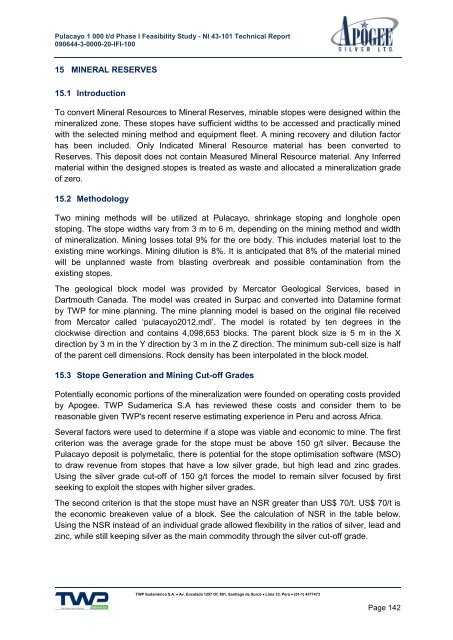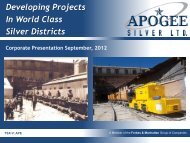Pulacayo Project Feasibility Study - Apogee Silver
Pulacayo Project Feasibility Study - Apogee Silver
Pulacayo Project Feasibility Study - Apogee Silver
You also want an ePaper? Increase the reach of your titles
YUMPU automatically turns print PDFs into web optimized ePapers that Google loves.
<strong>Pulacayo</strong> 1 000 t/d Phase I <strong>Feasibility</strong> <strong>Study</strong> - NI 43-101 Technical Report<br />
090644-3-0000-20-IFI-100<br />
15 MINERAL RESERVES<br />
15.1 Introduction<br />
To convert Mineral Resources to Mineral Reserves, minable stopes were designed within the<br />
mineralized zone. These stopes have sufficient widths to be accessed and practically mined<br />
with the selected mining method and equipment fleet. A mining recovery and dilution factor<br />
has been included. Only Indicated Mineral Resource material has been converted to<br />
Reserves. This deposit does not contain Measured Mineral Resource material. Any Inferred<br />
material within the designed stopes is treated as waste and allocated a mineralization grade<br />
of zero.<br />
15.2 Methodology<br />
Two mining methods will be utilized at <strong>Pulacayo</strong>, shrinkage stoping and longhole open<br />
stoping. The stope widths vary from 3 m to 6 m, depending on the mining method and width<br />
of mineralization. Mining losses total 9% for the ore body. This includes material lost to the<br />
existing mine workings. Mining dilution is 8%. It is anticipated that 8% of the material mined<br />
will be unplanned waste from blasting overbreak and possible contamination from the<br />
existing stopes.<br />
The geological block model was provided by Mercator Geological Services, based in<br />
Dartmouth Canada. The model was created in Surpac and converted into Datamine format<br />
by TWP for mine planning. The mine planning model is based on the original file received<br />
from Mercator called ‘pulacayo2012.mdl’. The model is rotated by ten degrees in the<br />
clockwise direction and contains 4,098,653 blocks. The parent block size is 5 m in the X<br />
direction by 3 m in the Y direction by 3 m in the Z direction. The minimum sub-cell size is half<br />
of the parent cell dimensions. Rock density has been interpolated in the block model.<br />
15.3 Stope Generation and Mining Cut-off Grades<br />
Potentially economic portions of the mineralization were founded on operating costs provided<br />
by <strong>Apogee</strong>. TWP Sudamerica S.A has reviewed these costs and consider them to be<br />
reasonable given TWP's recent reserve estimating experience in Peru and across Africa.<br />
Several factors were used to determine if a stope was viable and economic to mine. The first<br />
criterion was the average grade for the stope must be above 150 g/t silver. Because the<br />
<strong>Pulacayo</strong> deposit is polymetalic, there is potential for the stope optimisation software (MSO)<br />
to draw revenue from stopes that have a low silver grade, but high lead and zinc grades.<br />
Using the silver grade cut-off of 150 g/t forces the model to remain silver focused by first<br />
seeking to exploit the stopes with higher silver grades.<br />
The second criterion is that the stope must have an NSR greater than US$ 70/t. US$ 70/t is<br />
the economic breakeven value of a block. See the calculation of NSR in the table below.<br />
Using the NSR instead of an individual grade allowed flexibility in the ratios of silver, lead and<br />
zinc, while still keeping silver as the main commodity through the silver cut-off grade.<br />
TWP Sudamérica S.A. Av. Encalada 1257 Of. 801, Santiago de Surco Lima 33, Perú (51-1) 4377473<br />
Page 142



